To elevate your phone action shots, master burst mode to capture multiple frames per second. Use pre-focus techniques to lock focus on fast-moving subjects. Experiment with shutter speeds to freeze motion or create artistic blur. Perfect your panning skills for smooth tracking shots. Embrace high frame rate video for dramatic slow-motion effects. Compose your shots with lead room and interesting angles to convey movement. Stabilize your smartphone using proper grip techniques or accessories. Edit your images to enhance contrast and sharpness for maximum impact. Practice anticipating and timing your shots to capture decisive moments. These pro tips will transform your mobile photography skills and help you create stunning action images.
Master Burst Mode
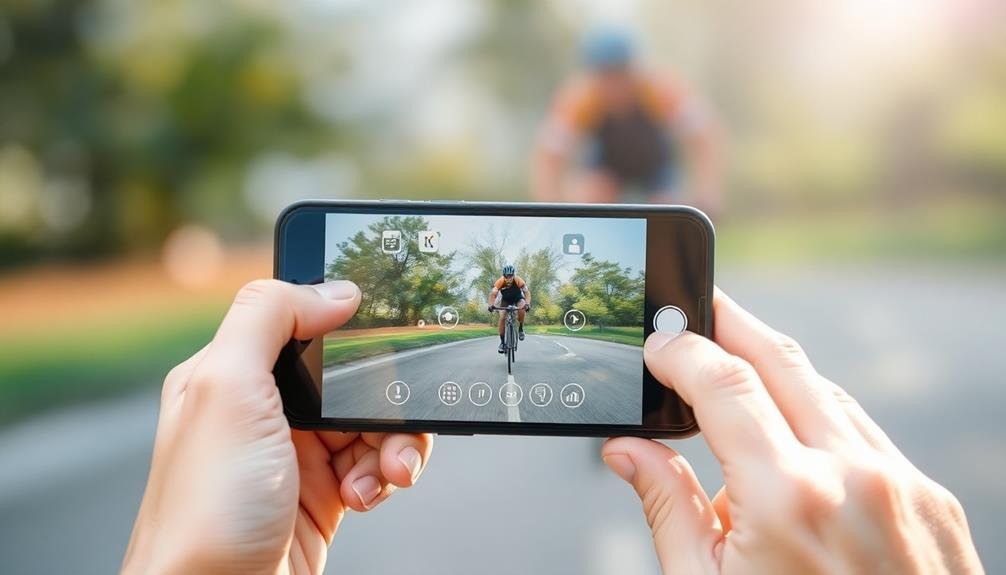
With burst mode, you'll never miss an essential moment in fast-paced action. This feature allows your phone to capture multiple frames per second, giving you a series of shots to choose from. To activate burst mode on most smartphones, simply press and hold the shutter button. Some devices may require you to swipe the shutter button to engage this function.
When shooting action, anticipate the peak moment and start your burst slightly before it happens. This guarantees you capture the entire sequence, including the build-up and follow-through. Experiment with different burst durations to find the right balance between coverage and manageable file sizes.
After capturing your burst, review the sequence and select the best frames. Look for sharp focus, interesting compositions, and peak action moments. Most phones offer built-in tools to help you choose and save the best shots from a burst.
Remember that burst mode consumes more storage and battery power than standard shots. Clear space on your device before an action-packed shoot, and consider carrying a portable charger.
With practice, you'll master the timing and technique of burst mode, elevating your action photography to new heights.
Utilize Pre-Focus Techniques
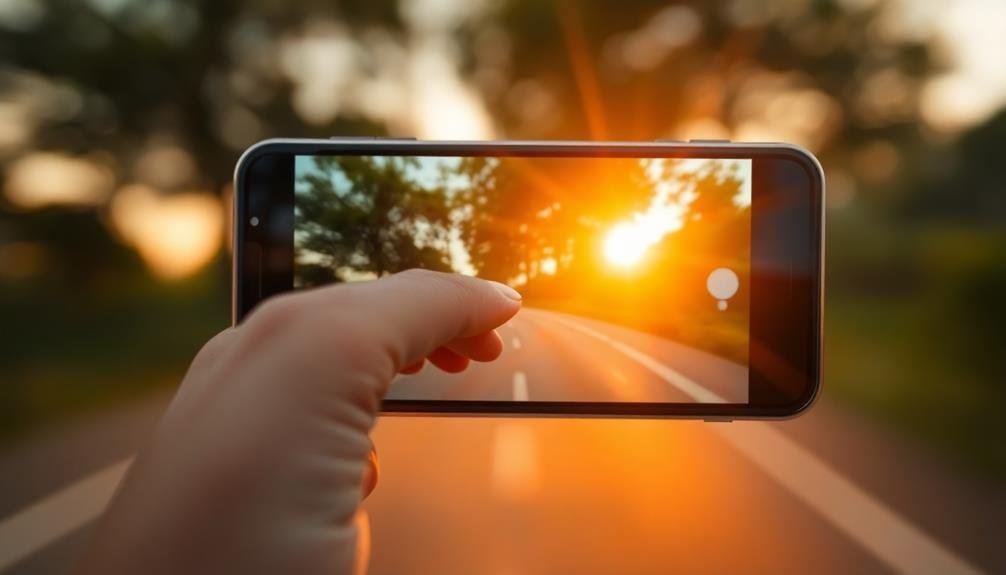
When capturing fast-moving subjects, pre-focusing can make a world of difference in your action shots. This technique allows you to lock focus on a specific area where you anticipate the action to occur, ensuring sharp images even with rapid movements.
To utilize pre-focus effectively, follow these steps:
- Identify the spot where your subject will pass through
- Frame your shot and tap that area on your screen
- Hold your finger on the screen to lock focus and exposure
- Wait for the subject to enter the frame, then shoot
Here's a quick reference guide for pre-focus techniques in different scenarios:
| Scenario | Pre-Focus Technique | Tips |
|---|---|---|
| Sports | Focus on goal/finish line | Anticipate player movements |
| Wildlife | Focus on feeding area | Be patient and stay quiet |
| Street photography | Focus on busy intersection | Look for interesting compositions |
| Vehicles | Focus on a bend in the road | Use a slower shutter speed for motion blur |
| Performances | Focus on stage mark | Predict performer's movements |
Experiment With Shutter Speed

You'll find that shutter speed is a powerful tool for capturing action shots on your phone.
Fast shutter speeds freeze motion, while slow speeds create artistic blur effects.
To master these techniques, you'll need to familiarize yourself with your phone's manual mode settings and practice adjusting the shutter speed for different scenarios.
Fast vs. Slow Effects
Experimenting with shutter speed opens up a world of creative possibilities for your phone action shots. When capturing fast-moving subjects, you'll want to use a fast shutter speed to freeze the action. This technique works well for sports, wildlife, or any quick movements you want to capture crisply. Aim for speeds of 1/500th of a second or faster to eliminate motion blur.
On the flip side, slow shutter speeds can create stunning effects that convey motion and energy. By using speeds of 1/15th of a second or slower, you'll introduce intentional blur to your images. This technique is perfect for waterfalls, light trails, or capturing the hustle and bustle of a busy street.
To achieve sharp results with slow shutter speeds, use a tripod or stabilize your phone against a solid surface.
Don't be afraid to push the limits of your phone's camera. Many modern smartphones offer pro modes that allow manual control over shutter speed. If your phone doesn't have this feature, look for third-party apps that give you more control.
Mastering Manual Mode Settings
The key to unfastening your phone's full photographic potential lies in mastering manual mode settings. Experiment with shutter speed to capture stunning action shots. Slower shutter speeds create motion blur, while faster ones freeze movement.
Start by setting your phone's camera to manual or pro mode, then adjust the shutter speed to match your subject's motion. For fast-moving subjects like sports or wildlife, use shutter speeds of 1/500th or faster. This will freeze the action, capturing crisp details.
For artistic shots of flowing water or light trails, try slower speeds like 1/15th or even several seconds. Remember, slower shutter speeds require a steady hand or tripod to avoid camera shake.
As you experiment with shutter speed, you'll need to adjust other settings to maintain proper exposure:
- ISO: Increase for faster shutter speeds in low light
- Aperture: Open wider (lower f-number) for faster shutter speeds
- Exposure compensation: Fine-tune brightness as needed
- White balance: Adjust for different lighting conditions
Practice these techniques regularly, and you'll soon be capturing professional-quality action shots with your phone's camera.
Don't be afraid to push your creativity and try new combinations of settings for unique results.
Perfect Your Panning Skills

To master panning shots, you'll need to follow your subject's motion smoothly while keeping your upper body steady.
Plant your feet firmly and rotate from the waist, maintaining a consistent speed as you track the moving object.
With practice, you'll refine your ability to control the panning speed, resulting in sharp subjects against beautifully blurred backgrounds.
Follow the Motion
Photographers know that capturing motion is an art form, and panning is a key technique to master. To follow the motion effectively, you'll need to sync your movement with your subject. As you track the moving object, keep your phone parallel to its path. This technique creates a sharp subject against a beautifully blurred background, emphasizing the sense of speed and action.
Start by identifying your subject's direction and speed. Then, position yourself for the best angle and lighting. As the subject approaches, begin moving your phone smoothly in the same direction. Maintain a steady hand and consistent speed throughout the shot. Remember to continue the motion even after you've pressed the shutter button to guarantee a fluid image.
Practice is essential to perfecting this technique. Here are some key points to remember:
- Use a slower shutter speed to capture more motion blur
- Keep your elbows close to your body for stability
- Focus on a specific point on your subject
- Experiment with different subjects and speeds
Steady Your Stance
While mastering the art of following motion is key, your stance plays a vital role in capturing stunning action shots. To steady your stance, start by planting your feet shoulder-width apart. This wider base provides stability and reduces camera shake. Bend your knees slightly to absorb any sudden movements and keep your upper body relaxed.
When panning, rotate your body from the hips rather than twisting your torso. This smoother motion helps maintain a level horizon and keeps your subject in frame. Practice this technique by following slow-moving objects before attempting faster subjects.
Hold your phone with both hands, keeping your elbows tucked close to your body for added support. If possible, lean against a stable object like a wall or tree to further minimize shake.
For longer exposures or in low light conditions, consider using a mobile tripod or gimbal for maximum stability.
Remember to breathe steadily and avoid holding your breath, which can cause tension and unintended movement. By perfecting your stance and panning technique, you'll greatly improve the sharpness and overall quality of your action shots.
Practice Speed Control
Speed control is perhaps the most essential aspect of perfecting your panning skills for action shots. To capture crisp, dynamic images, you'll need to match your camera's movement with your subject's speed. Start by practicing with slower-moving subjects, like joggers or cyclists, before tackling faster objects like cars or athletes.
As you pan, keep your arms close to your body and pivot smoothly from your waist, maintaining a consistent speed throughout the motion.
Experiment with different shutter speeds to achieve various effects. Slower shutter speeds (1/15 to 1/60 second) will create more background blur, emphasizing motion, while faster speeds (1/125 to 1/250 second) will freeze more of the action.
Don't be discouraged if your first attempts aren't perfect – panning takes practice and patience to master.
Here are key points to remember when practicing speed control:
- Always focus on your subject's eyes or most prominent feature
- Use burst mode to increase your chances of getting a sharp shot
- Try pre-focusing on a specific spot where your subject will pass
- Adjust your camera's continuous autofocus settings for better tracking
Embrace High Frame Rate Video

High frame rate video is a game-changer for capturing phone action shots. Most modern smartphones offer this feature, typically allowing you to record at 60, 120, or even 240 frames per second (fps). By embracing high frame rate video, you'll reveal the ability to create stunning slow-motion sequences that reveal intricate details of fast-moving subjects.
To use this feature effectively, start by selecting the highest frame rate available on your device. Remember that higher frame rates often come with reduced resolution, so balance quality with speed.
When filming, verify your subject is well-lit, as faster shutter speeds require more light. Hold your phone steady or use a tripod for the best results.
After capturing your high frame rate footage, you can edit it to create dramatic slow-motion effects. Most phone editing apps allow you to adjust the playback speed, letting you highlight specific moments or create a cinematic feel.
Experiment with varying speeds within a single clip for added impact. By mastering high frame rate video, you'll elevate your action shots and bring a professional touch to your mobile photography.
Explore Slow Motion Capabilities

Slow motion capabilities take your action shots to the next level. Most modern smartphones offer this feature, allowing you to capture stunning footage that reveals details invisible to the naked eye.
To make the most of slow motion, choose a well-lit environment and focus on subjects with fast, dynamic movements. Experiment with different frame rates to find the perfect balance between smoothness and playback duration.
When editing, consider mixing regular speed and slow-motion segments for a more engaging video. This technique can highlight key moments and create a fascinating narrative flow. Don't forget to stabilize your footage in post-production to minimize any shakiness that becomes more noticeable in slow motion.
To elevate your slow-motion game:
- Practice timing to start recording just before the action begins
- Use a tripod or stabilizer for smoother results
- Experiment with different angles to capture unique perspectives
- Incorporate dramatic lighting to enhance the visual impact
Optimize Camera Settings

To capture stunning action shots, it's crucial to optimize your phone's camera settings. Start by enabling burst mode, which allows you to take multiple photos in quick succession. This increases your chances of capturing the perfect moment.
Next, switch to manual mode if your phone offers it. Here, you can adjust shutter speed, ISO, and focus to suit the action you're shooting. For fast-moving subjects, use a higher shutter speed to freeze motion. In low light, increase the ISO, but be mindful of noise. Set your focus to continuous or tracking mode to keep moving subjects sharp.
If your phone has pro or expert mode, experiment with different presets for sports or action photography. Don't forget about exposure compensation. Slightly underexposing can help maintain detail in highlights, especially in bright conditions.
Enable HDR for high-contrast scenes, but be aware it may slow down your shooting speed. Finally, turn on grid lines to help with composition, ensuring your action shots are well-framed.
Remember to practice with these settings before important events to familiarize yourself with their effects on your photos.
Leverage Natural Light

While optimizing camera settings is important, mastering natural light can elevate your phone action shots to the next level. Natural light provides a softness and depth that artificial lighting often struggles to replicate.
When shooting outdoors, aim to capture your subjects during the golden hour—just after sunrise or before sunset—when the light is warm and diffused.
Position your subject so that the light falls on them from the side or at a 45-degree angle. This creates depth and highlights the contours of their face or body. If you're dealing with harsh midday sun, seek out shaded areas or use a diffuser to soften the light.
Don't be afraid to experiment with backlighting, which can create stunning silhouettes and dramatic effects.
For indoor shots, position your subject near a window to take advantage of natural light. Avoid using your phone's flash, as it can create unflattering shadows and wash out your subject's features.
- Use reflectors to bounce light onto your subject
- Experiment with different angles to find the most flattering light
- Pay attention to shadows and use them creatively
- Adjust your white balance to match the natural light source
Capture Decisive Moments

To capture decisive moments in action shots, you'll need to hone your timing and technique.
Anticipate the peak of the action and be ready to press the shutter at the perfect instant.
Use your phone's continuous shooting mode to increase your chances of catching the ideal frame, and pre-focus on the area where the action will unfold for sharp, precise images.
Anticipate the Peak
Capturing the perfect moment in action photography requires keen observation and anticipation. To anticipate the peak of action, you'll need to study your subject's movements and predict when the most visually interesting moment will occur. This skill comes with practice and patience, but it's essential for creating stunning action shots.
Pay attention to the rhythm and flow of the action. Whether you're photographing a skateboarder, a dancer, or a sports event, there's usually a pattern to the movement. By identifying these patterns, you can better predict when the peak moment will happen.
Don't be afraid to take multiple shots in quick succession; this increases your chances of catching that split-second of perfection.
To improve your ability to anticipate the peak:
- Study your subject before shooting
- Look for repeating patterns in the action
- Practice timing your shots
- Review your images and learn from missed opportunities
Master Continuous Shooting Mode
Continuous shooting mode can make or break your action photography. This feature allows you to capture multiple images in rapid succession, increasing your chances of freezing the perfect moment.
To master this technique, first locate the burst mode or continuous shooting option in your phone's camera app. It's often represented by an icon with multiple squares or a fast-forward symbol.
When you're ready to shoot, press and hold the shutter button to start the burst. Keep it pressed until the action is complete. Most phones can capture up to 10 frames per second, giving you plenty of options to choose from later.
Remember, timing is essential. Start the burst slightly before the anticipated peak action and continue through it.
After shooting, review your burst sequence and select the best shots. Look for frames that capture the height of the action, interesting expressions, or unique compositions.
Don't be afraid to experiment with different angles and distances to add variety to your burst sequences. With practice, you'll develop a keen sense of when to start and stop your bursts, maximizing your chances of capturing those decisive moments in action photography.
Pre-Focus for Precision
When you're aiming to capture decisive moments in action photography, pre-focusing can be your secret weapon. This technique allows you to lock focus on a specific point where you anticipate the action will occur, ensuring sharp images even in fast-paced scenarios.
To pre-focus, simply tap on the area of your phone's screen where you expect the subject to be. Once focus is set, hold your finger on that spot until you're ready to shoot.
Pre-focusing is particularly useful in situations where you can predict the subject's movement, such as a runner crossing a finish line or a bird landing on a specific branch. It's also helpful in low-light conditions where autofocus might struggle to keep up with moving subjects.
Here are some key benefits of mastering pre-focus:
- Reduced shutter lag for split-second timing
- Improved focus accuracy in challenging conditions
- Greater control over composition
- Ability to capture fleeting moments with precision
Remember to practice this technique in various scenarios to develop your instincts.
With time, you'll find yourself anticipating and capturing those decisive moments with remarkable consistency, elevating your action photography to new heights.
Compose for Movement
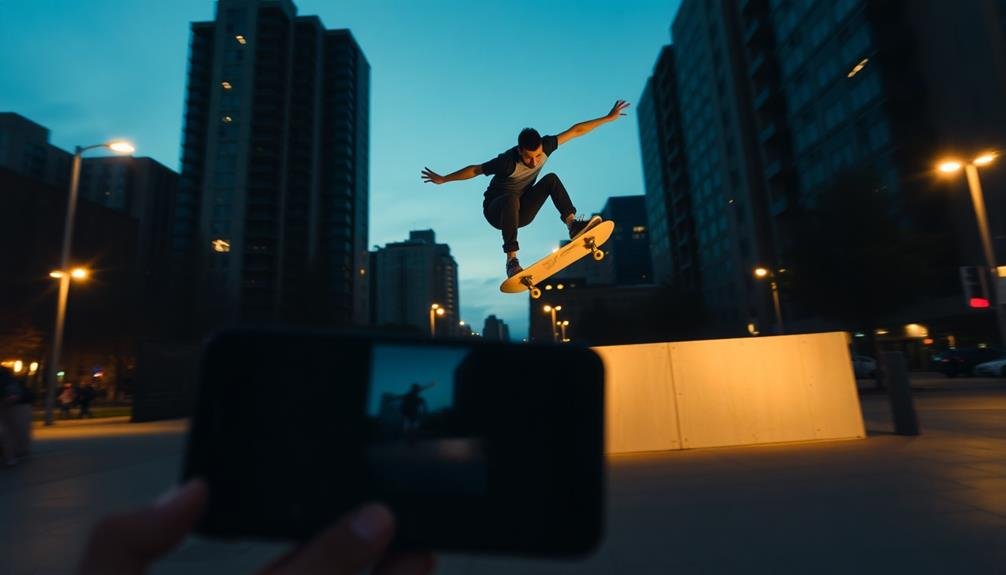
Movement composition is key to creating dynamic phone action shots. When framing your subject, consider the direction they're moving and leave space for them to "move into" within the frame. This technique, known as lead room or lead space, creates a sense of motion and prevents your subject from feeling cramped.
Try positioning your subject off-center using the rule of thirds. Place them in the left or right third of the frame, depending on their direction of movement. This asymmetry adds visual interest and helps convey the sense of action.
Experiment with different angles to enhance the feeling of movement. Low angles can make your subject appear more powerful and dramatic, while high angles can provide a unique perspective on the action.
Don't forget about the background. Look for leading lines or patterns that can guide the viewer's eye towards your moving subject. These elements can add depth and reinforce the sense of motion in your shot.
Lastly, consider using burst mode to capture a series of images. This gives you more options to choose from and increases your chances of getting the perfect moment of action.
Stabilize Your Smartphone

Steady hands are essential for capturing sharp action shots with your smartphone. Even with advanced image stabilization features, minimizing camera shake can greatly improve your photos. To achieve this, grip your phone firmly with both hands and keep your elbows close to your body. This creates a more stable platform for shooting.
Consider using physical supports to further stabilize your device. A small tripod or monopod can make a world of difference, especially in low-light conditions or when using slower shutter speeds. If you don't have a dedicated support, improvise by leaning against a wall or resting your phone on a stable surface.
For even better results, try these stabilization techniques:
- Use your phone's volume buttons as a shutter release to avoid tapping the screen
- Enable your camera app's grid feature to help maintain level horizons
- Utilize burst mode to increase your chances of capturing a sharp image
- Experiment with third-party camera apps that offer additional stabilization features
Edit for Dynamic Impact

Once you've captured your action shots, it's time to enhance their impact through editing. Start by adjusting the exposure and contrast to make your subject pop. Increase the shadows slightly to reveal hidden details, but be careful not to overdo it. Boost the vibrance to make colors more intense, which can add energy to your action shots.
Crop your image to improve composition and draw attention to the main subject. Don't be afraid to experiment with unconventional crops to create a more dynamic feel. Use the rule of thirds as a guide, placing your subject along the grid lines for a balanced yet exciting composition.
Apply selective sharpening to key areas of your image, such as the subject's face or any motion blur you want to emphasize. This technique can heighten the sense of movement and drama in your shot.
Consider using presets or filters that complement the mood of your action shot. A high-contrast, punchy look can work well for sports, while a softer, dreamy effect might suit dance or performance shots.
Always adjust the filter strength to maintain a natural appearance.
Practice Anticipation and Timing
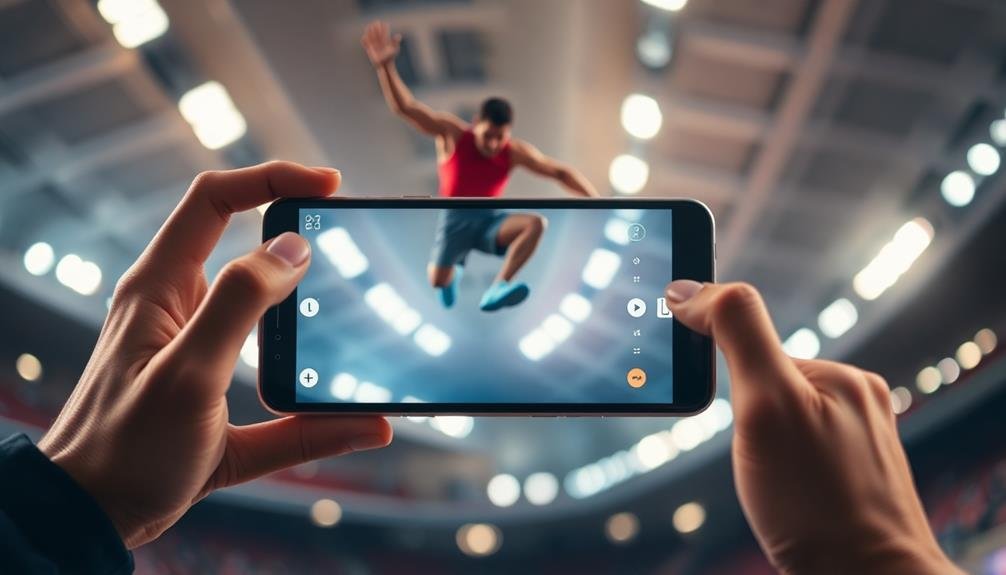
How can you capture the perfect moment in action photography? It's all about anticipation and timing. You'll need to develop a keen sense of when the action will peak and be ready to snap that shot at precisely the right instant.
Start by studying your subject's movements. Whether it's a skateboarder, a dancer, or a sports player, observe their patterns and routines. This knowledge will help you predict when the most dynamic moments will occur.
Position yourself strategically, considering both the background and the direction of movement.
Don't be afraid to take multiple shots in quick succession. Many phones now offer burst mode, which can be a game-changer for action photography. Remember, you can always delete the less impressive shots later.
To improve your anticipation and timing skills:
- Practice regularly with various subjects
- Learn to pre-focus on the spot where action will occur
- Use your phone's sports or action mode if available
- Pay attention to audio cues that might signal upcoming action
With consistent practice, you'll develop an intuitive sense of timing that will elevate your action shots from good to extraordinary.
Keep experimenting and refining your technique to capture those split-second moments that tell a compelling story.
Frequently Asked Questions
How Do I Protect My Phone While Capturing Action Shots in Extreme Conditions?
To protect your phone during extreme action shots, you'll want to invest in a waterproof, shockproof case. Use a lanyard or wrist strap for added security. Consider a lens protector and avoid sudden temperature changes to prevent damage.
What Accessories Can Enhance My Smartphone's Action Photography Capabilities?
You'll enhance your smartphone's action photography with accessories like clip-on lenses, tripods, and gimbals. Don't forget waterproof cases for underwater shots, and external microphones for better audio. A power bank guarantees you're always ready to capture.
Are There Specific Apps That Can Improve Action Shot Quality?
Yes, you'll find several apps to boost your action shot quality. Try Camera+ 2, ProCam, or ProShot for manual controls. Burst mode apps like Fast Burst Camera can help capture the perfect moment. Don't forget editing apps like Snapseed.
How Can I Achieve a Bokeh Effect in Smartphone Action Photography?
You can achieve a bokeh effect in smartphone action photography by using portrait mode, getting close to your subject, creating distance between subject and background, and adjusting aperture settings if available on your device.
What's the Best Way to Capture Action Shots in Low-Light Environments?
To capture action shots in low light, you'll need to increase your ISO and use a wider aperture. Don't forget to stabilize your phone, use burst mode, and experiment with slow-sync flash for more dynamic results.
In Summary
You've now got the tools to take your phone action shots to the next level. Remember, practice makes perfect. Don't be afraid to experiment with different techniques and settings. As you refine your skills, you'll capture more dynamic, exciting images. Keep pushing your boundaries, and soon you'll be shooting pro-level action photos with just your smartphone. Embrace the challenge, have fun, and watch your photography soar to new heights.



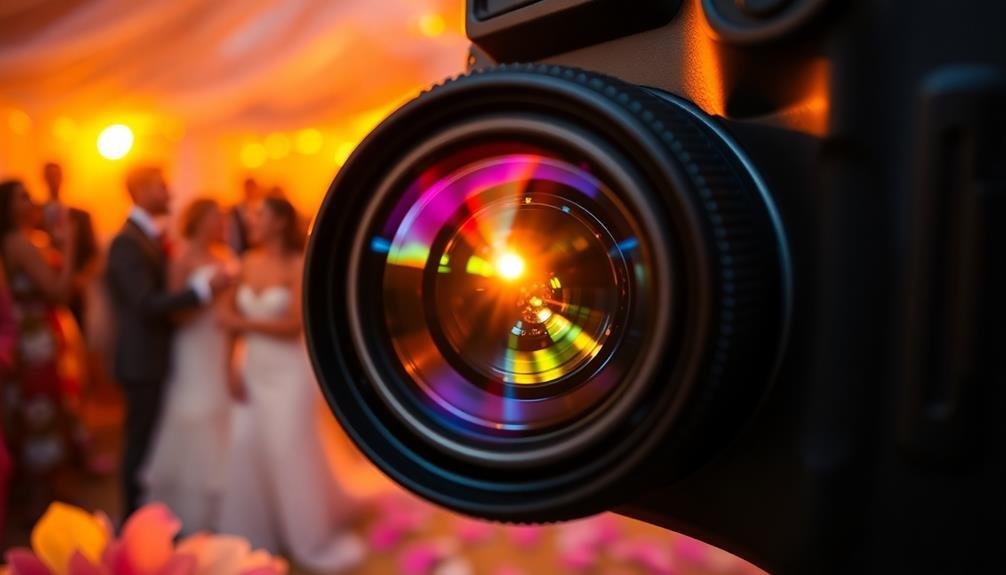

Leave a Reply